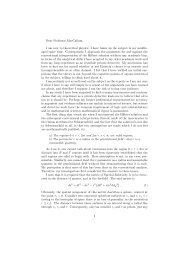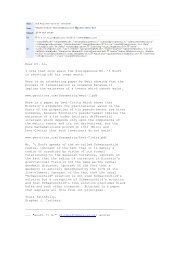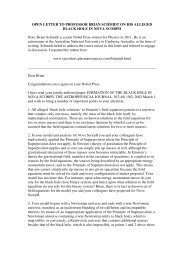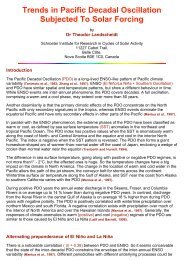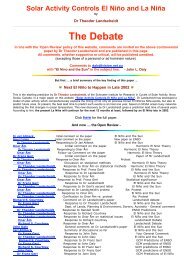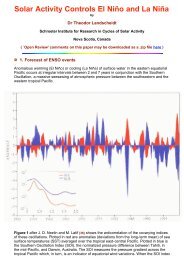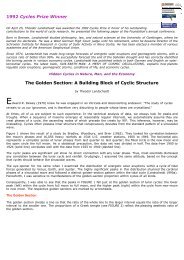Sun-Earth-Man - PlasmaResources
Sun-Earth-Man - PlasmaResources
Sun-Earth-Man - PlasmaResources
Create successful ePaper yourself
Turn your PDF publications into a flip-book with our unique Google optimized e-Paper software.
28 SUN-EARTH-MAN: A MESH OFCOSMIC OSCILLATIONS<br />
About 1968 to 1972: Upheavals and rebellions of students all over the world;<br />
spread of hippies; Cultural revoIution in China; six day<br />
Arab-Israeli war; new economic stmdures in<br />
Czechoslovakia, suppressed by Russian invasion;<br />
turnlng point in Vietnam; space travel; astronauts on<br />
the Moon; Glomar Challenger expedition, plate<br />
tectonics; first Aids infections; ecological movement;<br />
Gnostics of Princeton; Pop art.<br />
The next major instability event will start about 2002 and last till 2011. This is<br />
an exceptionally long period. It is impossible to predict the details of its historic<br />
effects. But the basic quality of all boundary functions will be evident: the years<br />
past 2002 will prove to be another lurning point, a period of instability,<br />
upheaval, agitat~on, and revolution, that ;ins traditional structures, but<br />
favours the emergence of new patterns in society, economy, art, and science.<br />
Furthermore, the rhythm in terrestrial time series that shows a connection with<br />
the <strong>Sun</strong>'s activity will change again. Perhaps people at the beginning of the<br />
third millenium will be better prepared to realize the dangers and chances of<br />
cosmic periods of change like these. Possibly, the holistic results presented<br />
here will contribute to such awareness.<br />
7. SOLAR TORQUE CYCLES, PRECAMBRIAN CLIMATE, AND<br />
CLASSICAL ASTROLOGICAL CONJUNCTIONS<br />
This is the end of our comprehensive example which demonshates the fertility<br />
of a genuine holistic approach that integrates basic astrological ideas with<br />
modern scientific knowledge. A single notion taken from the fields of<br />
mathematics and physics, a simple model of feed-back loops or cycles,<br />
seemingly infinitely apart from astrological views, when looked at in an<br />
unbiased multidisciplinary way, has been shown to yield new results that<br />
profoundly change our perspective Critics may object that impulses of the<br />
torque (IOT), even if initiated by conjunctions of Jupiter and the centre of mass,<br />
show no relation to traditional astrologcal constellations. But actually<br />
conjunctions and oppositions of the giant planets play a vital part in the <strong>Sun</strong>'s<br />
irreguIar motion about the centre of mass (CM). The <strong>Sun</strong> reaches exkreme<br />
positions relative to CM when traditional constellations are formed by Jupiter,<br />
Saturn, Uranus, and Neptune. When Jupiter on one side of the <strong>Sun</strong> is in<br />
opposition to Saturn, Uranus and Neptune on the other side, the <strong>Sun</strong>'s centre<br />
and the centre of mass CM come together, whereas the two centres reach their!;<br />
greatest distance when all of the four giant planets are in conjunction. he$<br />
synodic cycle of Jupiter and Saturn with a period of 19.86 years and cycles of<br />
double (39.72 yr), fourfold (79.44 yr), eightfold (158.9 yr), and 16-fold (317.8<br />
yr) length are of paramount importance in solar torque cycles. They even<br />
appear in the solar cycle in Precambrian tie, 680 million years ago, derived<br />
from records covering more than 16.000 years. According to G. E. Williams"<br />
the so-called "Elatina cycle" of solar activity, that shows a strong reiation, too,<br />
with climatic cyclicity, has an average duration of $14 years. This is near to the<br />
16th subharmonic (317 yr) of Jupiter's and saturn's conjunction cycle. The<br />
-<br />
II EXAMPLE AVAILSTENTIMES MORE THAN PRECEPT 2 9<br />
harmonics of 79 and 157 years in the "Elatina cycle" match the fourth (7'9 yyr)<br />
and 8th (158 yr) subharmonic of the synodic cycle of Jupiter and Saturn.<br />
A further classical constellation, the triple conjunction of Jupiter, Saturn,<br />
and Uranus, the period of which is 317.7 years, is lrnmed~ately related to the<br />
"Elatina cycle" and together to torque cycles. As will be shown, one of the<br />
most important torque cycles has a mean period of 13.3 years. It can be derived<br />
from the conjunction cycles of Jupiter and Neptune (12.8 yr) and Jupiter and<br />
Uranus (13.8 yr). The mean of both synodic cycles (13.3 yr) matches just the<br />
torque cycle of this length. Interestingly, the remaining harmonics of the<br />
"Elatina cycle" of 52,63, and 105 years can be derived from the 13.3-year torque<br />
cycle. They are near its 4th (53 yr), 5th (66 yr), and 8th (106 yr) subharmonic.<br />
There are many other relations that connect tradihonal astrological<br />
constellations with torque cycles, solar activity, and terrestrial effects. This<br />
shows that traditional astrology had hands on something, the precise contours<br />
of which, however., can only be worked out by unprejudiced investigations<br />
that make Interdisciplinary use of modern means of research. Astrologers<br />
should follow the respective pieces of advice given by H. Eysenck.&



